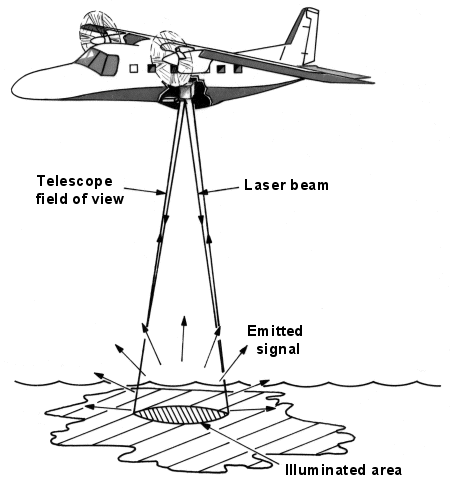7. Water Analysis Using Lidar
Lidar and laser fluorosensor
A lidar is an active sensor which is used to illuminate objects and to detect and analyse signals which originate from that object as a result of the illumination. It thus resembles a radar, however, it uses the ultraviolet (UV), visible (VIS) or infrared (IR) region of the electromagnetic spectrum instead of microwaves (see chapter 1 of the tutorial on Understanding Spectra from the Earth). Pulse lasers are used as a light source, since there is a high background radiation from sunlight in the UV, VIS and IR during the day. Daylight intensity is almost constant and therefore the signals which originate from laser pulses illuminating an object can be easily discriminated from the sunlight-induced background, and lidar can also be used during the day.
Just like radar, it is is possible to measure the distance r between the instrument and an object by measuring the time lapse t between laser pulse emission and return of the signal reflected by an object:
c is the velocity of light. In air it is approximately c=300 000 km/s oder 3·108 m/s. The velocity of light in water is about 75% of this value. The factor 2 in the denominator on the right side of the equation is due to the fact that the light pulse travels twice the distance r, forth and back. This is one of the fundamental lidar equations. The name lidar refers to the possibilities which result from the time lapse measurement of laser pulses: Light detection and ranging.
The signals returning from an object can be a reflection of the laser pulse. Knowing precisely the position and attitide of the aircraft and considering these data during signal processing makes it possible to construct very detailed maps of the land surface with a cm accuracy; this method is called airborne laser scanning or airborne lidar topographic mapping. In the same way it is possible to measure the depth of the sea floor in coastal seas down to water depths of about 50 m, and to plot nautical maps in regions where the waters are not too turbid; this is called airborne laser bathymetry.
Many objects absorb light and re-emit a fraction of it as fluorescent light. The spectral analysis of the fluorescent light makes it possible quite often to characterise the substances of which the object is composed. Lidar instruments which measure fluorescence are called fluorescence lidar or laser fluorosensor. They can be operated aboard an aircraft to analyse physical and biological parameters of waters such as the turbidity and the algae content, or to detect marine pollutants as shown in the graph below.

